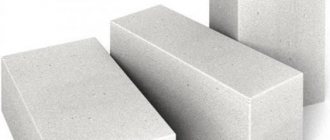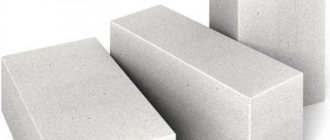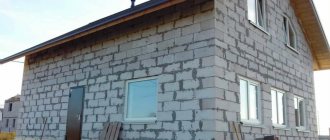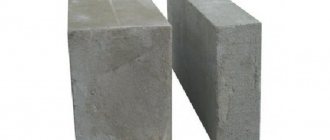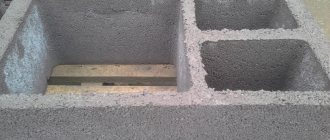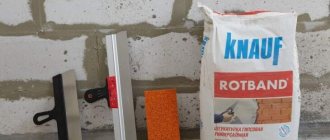For developers choosing material for building a house, it is important to know whether aerated concrete or gas silicate blocks are harmful to the health of residents. The difference in the properties of the material from traditional types of concrete raises a lot of questions and doubts.
Requirements for environmental friendliness and safety of building materials are constantly increasing. Manufacturers refuse to use harmful materials or components. Everyone has before their eyes a striking example of the use of asbestos-cement slate, a roofing material with carcinogenic properties and capable of causing cancer, during the Soviet era. In modern reality, the number of construction and finishing materials has increased many times, which creates noticeable difficulties for users due to a lack of knowledge about the properties, composition and other parameters of the assortment of construction stores. Therefore, many are interested in how safe it is to live in a house made of aerated concrete and what consequences this may have in the long term. Let us consider in detail whether gas blocks are harmful, what problems they can cause, whether the material is dangerous for people or not.
Composition and production technology of aerated concrete
In order to figure out whether aerated concrete is harmful to humans, it is necessary to study its composition. The following components are used in the manufacture of the material:
- cement;
- quartz sand;
- lime;
- plaster (sometimes);
- aluminum powder (or paste);
- water.
By themselves, these components do not pose any danger. There are often statements that gas silicate blocks are harmful to health in their finished form, due to the compounds and chemical reactions that occur during the technological process. Therefore, you should carefully consider the production technology of the material. Here we must immediately take into account the existence of autoclaved and non-autoclaved aerated concrete, which differ somewhat in production methods. The production of both types begins in the same way and diverges only at the final stage of acquiring brand strength.
Material manufacturing method
Technological diagram using the example of the production of YTONG gas blocks:
- The components are thoroughly crushed in crushers. The finer the grind, the better the final product.
- Using automatic dispensers, the components are mixed in the required proportions. Water is added and the mixture is placed in a mold to mature.
- During the aging process, aluminum powder reacts with lime and water. As a result, free aluminum passes into a bound form with the release of hydrogen and the formation of a large number of small (2-4 mm) bubbles throughout the entire volume of the material.
- Due to the release of gas, the raw material swells like dough. The exposure is carried out for several hours (depending on the brand of future gas blocks), then the form is sent into a hot tunnel to complete gas formation and gain stripping strength.
- After this, the array is removed and fed to the cutting line. Here, using special machines, cutting into blocks is carried out. The procedure is carried out using special strings and knives that ensure the exact geometry of the blocks.
- The formed gas blocks are sent to autoclaves, where they are processed for 12 hours under a pressure of 12 At and under the influence of superheated steam. From the autoclave, the material is sent for drying and packaging, after which the finished aerated blocks are sent for sale.
The production of non-autoclaved aerated concrete differs already at the final stage - after cutting into blocks, the material is fed into a room for steaming under high temperature conditions. The difference between the technologies is the absence of pressure at the strength building stage. At the same time, the properties of the two types of aerated concrete differ in many respects - if the autoclaved material receives final technical parameters, then non-autoclaved aerated concrete continues to gain strength and gradually changes its working qualities for the better.
Studying the technology, one can note the absence of chemical additives or complex processes. The only stage where a chemical reaction is used is the moment of ripening of the massif (gas formation). The reaction involves aluminum powder (usually a paste so that the material does not stick to the walls of the mold) in a percentage of 0.1% of the total mass of the mixture. As a result of the reaction, the component is processed entirely, no aluminum metal remains, it completely reacts with lime and transforms into another form. The basic processes are no different from traditional ones - cement with water and filler form a hard and durable material that can maintain the shape of the formwork when poured.
Is it safe to use?
Everyone knows that aluminum oxide can pose the greatest danger to the body. A comparative analysis of a block of aerated concrete and brick showed that there is eight times more of it in the latter. The lime present in the composition turns into potassium silicate during the production process.
Tests have proven that the blocks are fireproof materials. The level of radiation in them does not exceed permissible levels and is lower than in reinforced concrete products.
Do aerated concrete walls affect the humidity level in the room? The material absorbs excess moisture only when the walls are not finished with facing materials.
Some manufacturers mix slag and ash into the raw materials for aerated concrete blocks. These additives can be dangerous because they may contain copper, lead and cadmium. And this also affects the radioactivity indicator, changing it upward.
In order to fully determine the harmfulness of aerated concrete blocks, it is necessary to consider the release of hazardous components from the effects of natural phenomena, which include sunlight, heat, steam and moisture. Under the influence of all this, the blocks do not emit hazardous substances into the atmosphere due to their complete absence. There are no problems with aerated concrete material during the corrosion process.
With regard to the effects of steam, the following is obtained - the blocks are a “breathing” material, they provide an outlet for vapors to the outside, ventilating the room.
It turns out that the composition of the blocks does not create a danger either under normal operating conditions or in extreme situations.
How is aerated concrete superior to traditional building materials?
The main advantages of aerated concrete, for which it was created, are:
- light weight;
- low thermal conductivity.
It is these qualities that radically change approaches to construction and distinguish the material from traditional options. The light weight of aerated blocks allows you to reduce the thickness and depth of the foundation. This means reducing the amount of excavation work, reducing the amount of reinforcement for the frame and concrete for pouring. Considering that the cost and labor required to create support structures amount to 30 to 40% of the total estimate, the benefits of weight reduction cannot be overestimated.
The low thermal conductivity of aerated concrete is achieved due to the many cavities in the mass. They create conditions under which the material accumulates thermal energy and does not release it outside. There is an opportunity to save on heating. Moreover, if a one-time decrease in value occurs on the foundation, then a decrease in heating costs allows you to save during the entire life of the house.
There are also decorative benefits from obtaining a flat masonry plane - there is a saving on finishing materials, and the duration of work is reduced. However, little attention is paid to the environmental friendliness of aerated concrete blocks, considering this indicator to be of little importance. A rare user will be able to unambiguously answer the question whether an aerated block is harmful to human health without preparation. And the reason is not the lack of information, the inaccessibility of such information. Here, more practical issues come to the fore and obscure less prominent problems. Developers are primarily interested in the technical characteristics of the material, study strength indicators, determine the load-bearing capacity and other mechanical qualities of aerated concrete. Do aerated concrete blocks cause harm to health - a problem that is the last thing people think about.
What problems may arise when using aerated concrete?
There are often categorical statements online that aerated concrete is harmful to people. At the same time, what exactly is its harmfulness, and whether the gas silicate block is dangerous for the residents of the house, as a rule, is not explained.
Despite a lot of positive properties, the material has some disadvantages. They arose due to the presence of pores, but for a long time they became the reason for builders to refuse to use aerated blocks in construction:
- low strength;
- hygroscopicity.
The first minus determines the ability to build houses with a large number of floors. The most popular brands of blocks (M500 or M600), according to SNiP standards, can be used to build houses up to 3 floors. For private housing construction, this is quite enough, but the construction of critical structures from such material is impossible.
The second flaw has become the subject of fierce debate. Opponents of aerated concrete argue that the material takes on too much water and becomes heavier, loses its heat-saving properties, and is destroyed by the frosty expansion of ice. At the same time, they completely do not take into account the scale of these phenomena. All of them really do occur (or at least are possible), but they arise only in one case - the absence of a protective coating, difficult climatic conditions in the region, an abundance of precipitation or extremely high air humidity. However, even at the drafting stage, all these factors are taken into account and taken into account. Exterior finishing, impregnating compounds, cladding - these options are actively used and give quite effective results.
Radiation hazard of gas blocks
Another problem common to all building materials is radioactivity. It is especially high in natural materials - stone (especially rocks of volcanic origin), somewhat reduced in piece materials made of baked clay (face or finishing brick), and is present in sweat (traditional) concrete. According to the results of the studies, the radioactivity index (NR) for different materials was:
- facing and ordinary bricks - 0.9;
- concrete - 0.66
- aerated concrete - 0.5.
The maximum permissible value of the radioactivity index is 1. The danger is represented by the radioactive gas radon, released during the decay of nucleides and poisoning the air in rooms (it is not dangerous on the street, since it quickly dissolves in the atmosphere). Radon causes headaches, general deterioration in health, and allergic reactions in people. Radon is first released into cracks and capillaries of the material, from where the gas is released into the internal atmosphere of the house. The problem is that radon can accumulate in certain areas of the house. It is 7 times heavier than air and can be present in basements, basements or technical rooms. Often poisoning occurs among specialists who inspect or repair communications, lay cables or fiber-optic communications.
The radiation index of aerated concrete is 0.5, which is much lower than that of brick or concrete that is considered safe. However, this indicator is not the only one and is not able to completely refute the claim that aerated concrete blocks are harmful to health.
Is the use of gas blocks harmful?
Aerated concrete is characterized by stability and unchanged parameters. During processing, the autoclave material completely completes its aging process, gains structural strength and no longer changes its qualities. Non-autoclaved aerated concrete is somewhat different, in which the ripening process continues throughout its entire service life. However, the changes that occur have a positive effect on the properties of the material - strength increases, the blocks become harder, and their load-bearing capacity increases. This demonstrates the uniqueness of non-autoclaved aerated concrete as a building material, since other materials only lose their original properties over time.
Some manufacturers introduce ash, slag and combustion plant waste into the material. This is done to increase production volumes using cheap fillers. However, the material becomes less safe, since the additives contain lead, copper, and cadmium isotopes. The introduction of these components slightly increases the radioactivity index (albeit slightly). At the same time, the use of additional components is not a technological error or deviation, since there are no strict GOST requirements for the composition of aerated concrete, all standards are advisory in nature. In addition, the amount of harmful components is insignificant and cannot be considered as a serious danger to users.
Is there any harm to the body from gas silicate blocks?
Aerated concrete block material is becoming popular in the building materials market. It is convenient and quick to install, saving time and money. However, in our time, the issue related to the environmental cleanliness of housing is gaining relevance, and consumers are interested in whether gas silicate blocks are harmful to health. There are certain documents that put forward relevant requirements that are observed when designing facilities and selecting building materials. For the construction of residential premises for residential, office and industrial purposes, materials that meet regulatory requirements are used. These include aerated concrete. Is there any harm from gas silicate blocks? Let’s try to figure it out.
Results of environmental assessment
Aerated concrete is a familiar and common material in Europe. It has been actively used there since the 70s of the last century, which makes it possible to study statistics and answer the question of whether gas silicate or aerated concrete blocks are harmful to health. European environmental organizations carried out an examination, which resulted in the following conclusions:
- the environmental safety of aerated concrete is approximately equal to that of wood, glass or brick;
- under normal conditions, gas blocks do not emit any volatile substances;
- in case of fire, the material is capable of holding the flame for a long time (about 4 hours or more) and cutting off adjacent rooms from contact with open fire and smoke;
- The radiation activity indicators of gas blocks are lower than those of most alternative building materials.
These findings quite eloquently answer the question of how harmful aerated concrete blocks are to people and animals.
Safety requirements when installing blocks
The building blocks themselves do not pose any health hazard, but it can arise during work with them if safety instructions are not followed.
All builders know the dangers of concrete dust present in the air when mixing solutions, grinding, cutting, drilling products and other manipulations with them. But the greatest danger is faced by workers at cement factories, where it is constantly present.
Cutting an aerated concrete block with an electric saw
Let us tell you why concrete dust, consisting mainly of cement particles, is harmful:
- When cement dust gets into the eyes and mucous membranes, it irritates them. If this happens regularly, their protective functions are weakened, leading to partial or complete loss of vision.
- The skin also suffers from this effect, since cement actively absorbs moisture. Dry skin is a very unpleasant thing. And over time, painful cracks and bleeding wounds may appear on the skin, which are open gates for various infections.
- By inhaling cement dust, a person risks getting lung diseases. Their delicate tissue becomes rough and destroyed from such exposure. The result most often is chronic bronchitis and asthma.
How is aerated concrete harmful from this point of view?
For people who will live in a house built from it - nothing. But if you are going to build it yourself, you need to take care of protective equipment at least for the duration of such construction operations as cutting to size, making grooves for reinforcement, etc.




